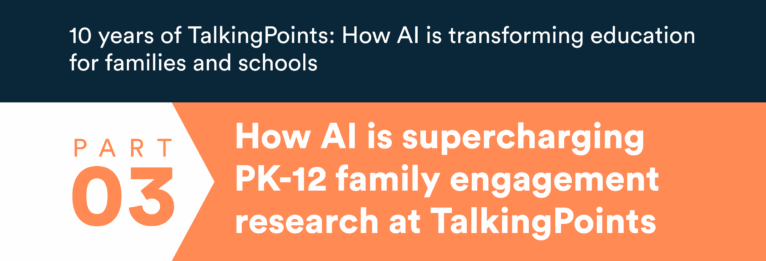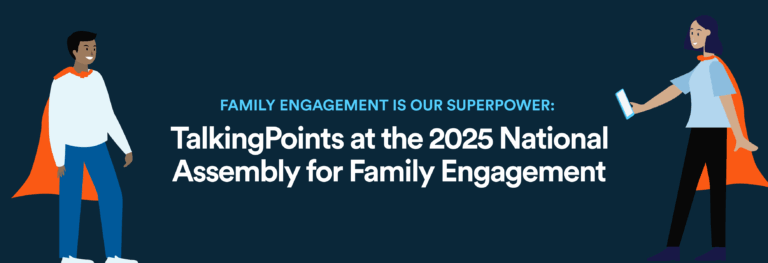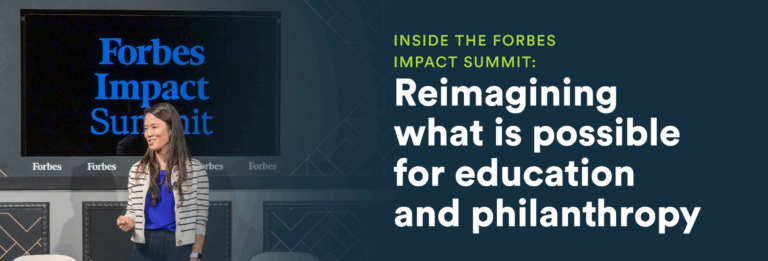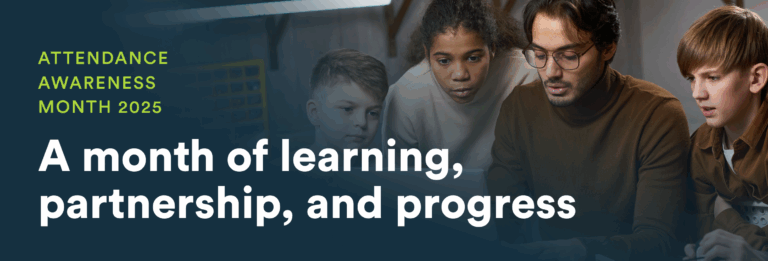A 5-part series on breaking barriers, building trust, and driving educational equity with AI
Right now, the discussion about AI in education is everywhere—dominating headlines, inspiring hope, and raising tough questions. From breakthrough innovations to concerns about equity and ethics, the conversation is loud and ongoing. And complicated.
So we want to cut through the noise and show some of the real ways AI is improving communities.
At TalkingPoints, we believe the most important question isn’t ‘How do you use AI?’—it’s: ‘How can we use AI to do the most good for students, families, and educators—especially in communities that have long been under-resourced?’
As we celebrate 10 years of impact, we’re launching a new blog series to explore that question from our perspective as an AI-native organization. Over five parts, we’ll spotlight how we’ve used AI to break down barriers and unlock the superpower of families. We’ll share what we’ve learned along the way and what’s next as we build toward a brighter future in education.
We’re excited to share our reflections, tools, and lessons learned—and to hear from you. What questions are you asking about AI? What possibilities are you exploring? Let’s shape the future together.
![]()
Have thoughts, hopes, or worries about AI in education? Send us a note—we’re listening.
![]()
Part 3: How AI is supercharging PK-12 family engagement research at TalkingPoints
 Written By Mallary Swartz
Written By Mallary Swartz
Director of Research at TalkingPoints
When I think about what drew me to TalkingPoints, it comes down to a foundational belief that has shaped my career: meaningful family engagement isn’t just beneficial — it’s essential. For 25 years as an applied researcher and educator, I’ve seen this truth from many angles. I began as an infant and toddler teacher, then worked across early childhood and K–12, and in every stage, I’ve witnessed how transformative it is when families and educators build trusting relationships through open, effective communication. When families feel welcomed and heard — and when educators see families as true partners in their children’s success — incredible things happen. Those relationships become the foundation for students to thrive academically, socially, and emotionally.
As a mom of a middle schooler and a high schooler, I see this every day in my own life. Just this morning, I sent a quick note to my son’s school to share my appreciation — and it made me wonder how powerful it would be if every parent and educator had an easy way to share those small gestures of connection. That’s what TalkingPoints makes possible, and it’s one of the many reasons it feels like such a special place to me.
Leading the research team here brings together everything I care about most: learning what truly works for families and educators, building actionable evidence, and transforming insights into meaningful change. AI is helping us dream bigger and learn faster — uncovering insights and driving impact at a scale I couldn’t have imagined early in my career. It’s such an exciting time, because AI gives us an even greater opportunity to make those meaningful partnerships possible for every student, every day — helping them thrive inside and outside the classroom.
How our rigorous research approach drives impact
At TalkingPoints, research is a central part of how we build, learn, and partner with educators and families. Research and data inform our decisions at every organizational level, guiding our approach based on where we see the strongest results. It helps shape the “how,” “what,” and “why” of the interventions and resources we test and embed into the TalkingPoints platform and how we support our partners.
Our strategy is rigorous and based on continuous learning so we can stay responsive to the evolving needs of those we serve. We engage in formal, large-scale research to push the boundaries of what is known about engaging families across the broader field. And, we conduct smaller-scale, exploratory research to be nimble and test new ideas to incorporate relevant findings back into our roadmap more quickly. We bring deep internal research and educational technology expertise, and we collaborate with external partners to stretch our thinking and challenge our assumptions. Our deep expertise and diverse methods are what makes our team more effective and our work more impactful.
Across our research, the trend is clear: the more educators and families use TalkingPoints, the more students are more likely to attend school and engage in learning.
Today, we have multiple proof points and clear evidence that we are measurably reducing student absenteeism, for example. Our first quasi-experimental study (QES) in a large, urban district confirmed a 15% decrease in absenteeism, while a more recent QES in Tulsa Public Schools found a 24% drop — equivalent to six more days of learning per student each year. That improvement makes TalkingPoints one of the most cost-effective solutions available to school systems when considering the cost of impact per student. Research has also shown that using TalkingPoints produces gains in both math and literacy – especially for students from traditionally underserved populations. And an even more recent study (coming soon!) has revealed specific attendance gains in high school, along with lower suspension rates.
![]()
Read more about recent TalkingPoints research studies here.
![]()
AI is supercharging our research
As an AI-native organization, we aren’t new to innovation – it’s in our DNA. But the rapid acceleration of AI is supercharging our research team in ways not possible before. We started by understanding how TalkingPoints breaks down the barriers that were preventing families – especially under-resourced families – from engaging with their child’s school. These are barriers like language, time, technology, and navigating a complicated education system. But our vision has always been bigger.
At TalkingPoints, we don’t just want families to be participants in their child’s education. We also want to actively guide families and school staff on how best to work together for student success.
We are achieving this through AI-powered research at scale. Advances in AI are allowing us to leverage decades of research and analyze billions of conversations between educators and families to demonstrate what works. This helps us provide families and educators with personalized support in the exact moment they need it, whether it is about academic content, individual student needs, or building trusting relationships between families and schools.
Despite mixed public opinions and skepticism, AI is here and already being widely used by educators and families alike. A recent Gallup poll from the Walton Family Foundation showed that the majority – 6 out of 10 – K-12 public school teachers are using AI in their classrooms. A survey by the National Parents Union found that 62% of parents believe the benefits of using AI in K-12 education outweigh the risks.
The question is not whether AI will be part of our education system; it is: how will we use it responsibly and effectively to make a lasting impact? Through research, we can leverage AI to learn more about how to close opportunity gaps and transform how schools support families and students to drive stronger outcomes.
Turning data and research into practice
The potential of AI lies not just in the amount of information it can surface, but in its ability to help people make sense of it and take action. At TalkingPoints, we’ve always believed that research should live not in white papers, but be embedded in resources and interventions reaching classrooms and homes. Here are some examples of how we’re using AI to bridge the gap between evidence and everyday practice.
We built a custom GPT loaded with the most comprehensive body of family engagement research available that members of our data, product, and research teams leverage to make their work more impactful. There are decades of studies and thousands of pages of academic research that point to the power of engaging families. We know educators and nonprofits like TalkingPoints care deeply about this work, but oftentimes the knowledge stays on the shelf and doesn’t make its way to being actively used in homes and classrooms where it can make a big difference.
What this means for families, educators and students
This enables us to integrate evidence-based strategies into our product development, data analysis, and daily decision-making. Because when we apply what works, students win.
We can prompt it with: “We are exploring building K-3 literacy tools to support learning at home. What are evidence-based best practices for how to approach designing and building these products?”
The model provides insights into what the research says, and supplements it with design considerations and practical strategies. That’s decades of peer-reviewed research, distilled into something clear and actionable. And, it’s available instantly.
As another example, we have a unique dataset of over 1.5 billion messages between families and schools spanning 150 languages. This is the largest dataset of home-school conversations anywhere. We have spent years mining this data to unlock incredible insights. But we haven’t been able to analyze them at scale until now. To put it in perspective: it would take one full-time researcher over 3.75 million hours – that’s 428 years! – to review the content we’ve now modeled to process in minutes.
“We have a unique dataset of over 1.5 billion messages between families and schools spanning 150 languages. This is the largest dataset of home-school conversations anywhere.”
We can detect tone, understand context, and recognize relationship-building patterns in conversations at a massive scale. We can analyze informal communication just as effectively as formal writing. We’re not just counting keywords or flagging messages as just ‘positive’ or ‘negative’; we’re understanding the true meaning behind them.
Here’s an example:
Schools have basic attendance codes, but clerks often add natural language notes for context. A parent calls about car trouble, and the clerk selects “Excused” but adds “Mom called – car trouble.” Another clerk might choose the same code but write “no transportation per father.” The model we built reads these natural language additions and identifies the actual patterns. Transportation issues. Illness. Medical appointments. Family obligations.
The power here is that districts get insights without forcing every attendance clerk across every school to use identical language or subcodes. One clerk writes “car trouble,” another types “transportation issue,” someone else puts “bus didn’t show.” We’re building capabilities like this into our new TalkingPoints Attendance Improvement solution to help streamline work being done by attendance staff, while also helping schools and districts better understand the types of attendance challenges and align support systems where they are needed most. This visibility changes everything for districts and schools. Now, a district can identify patterns across all its schools while still allowing clerks to use the flexible note-taking method that suits them. They’re noticing patterns such as: “We have a cluster of transportation-related absences in 4th grade across two campuses.” That’s actionable. That’s a bus route to investigate or a carpool program to organize.
When research and real-world data come together at scale, school systems can move from reactive to strategic, transforming family engagement from an initiative into a high-impact lever for student success.
Looking ahead: The future of AI-powered family engagement research
At TalkingPoints, we want our work to reach beyond the platform itself — sparking change in how educators and families partner and helping shape a world where every child can thrive inside and outside the classroom. With AI, we have the power to amplify human connection, not replace it, and significantly accelerate our impact.
Looking forward, our team is diving even deeper into rigorous research, both large- and small-scale, to expand the evidence base for effective family engagement and generate actionable insights for our partners. We’re unpacking the types of conversations and actions that drive the most impact, to help educators understand how these behaviors impact their students. We’re broadening our lens to include not only literacy, math, and attendance, but also other academic areas and well-being.
We’re so proud of the impact we’ve made over the last 10 years and even more energized by what’s still possible in the next decade to come.
![]()
Celebrating 10 years of partnership and impact
For a decade, TalkingPoints has supported students, families, and educators through the power of effective family-school partnerships. As an education technology nonprofit, our award-winning communication and family engagement platform has improved outcomes for districts and students across the country.
We connect 9 million+ educators, students, and family members annually and have facilitated more than one billion conversations—building trust, fostering relationships, and fueling student success. Named by Common Sense Education as “the best overall family communication platform for teachers and schools,” TalkingPoints drives measurable gains in attendance and academic achievement, backed by rigorous, causal research.
Join us in building a future where every child has the support they need to thrive.



